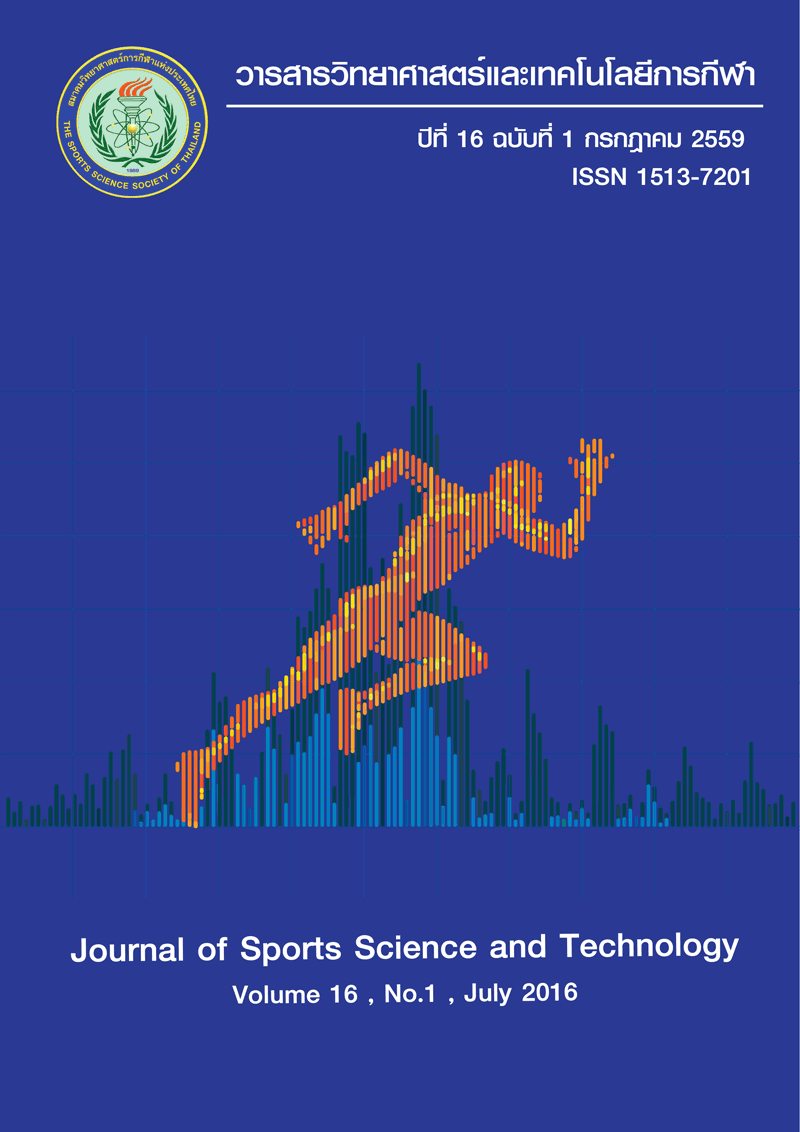EFFECTS OF HEIGHTS AND NUMBER OF JUMP ON JUMPING MECHANICS
Abstract
The objective of the present study was to investigate the effects of hurdle heights (100% and 140%CMJ height) and number of jumps on contact time (CT), peak vertical ground reaction force (p-VGRF),
eccentric rate of force development (E-RFD), leg stiffness (LS), vertical displacement of leg (ΔL), and
average electromyography (AEMG). Fourteen healthy male university athletes (aged: 20.7 ± 1.7 years, body
weight: 65.5 ± 4.5 kg, height: 173.6 ± 3.9 cm) were volunteered to participate in this study. Subjects were
asked to perform 15 continuously repeated hurdle jumpings (3 series) at 100% or 140% CMJ heights in a
randomized order. Each series consisted of 5 hurdle jumps and each hurdle was placed 1 meter apart. The
hurdle height for each subject was computed from the individual maximal CMJ height (100% CMJ). Two force
platforms were placed between the 2nd – 3rd and the 3rd – 4th hurdles. Electromyography was measured from
rectus femoris (RF) and vastus lateralis (VL), and the data were analysed from both eccentric (EC) and
concentric (CON) phases. Jumping mechanic and EMG variables were analysed from three series of jumps
(the 1st series = 1-5 jumps, the 2nd = 6-10 jumps, and the 3rd = 11-15 jumps). The results showed that 140%
CMJ height had lower LS, higher ΔL, and higher AEMG of RF and VL in EC phase than 100% CMJ height in
the 3rd series (p<0.05). Additionally, AEMG of VL in the CON phase of 140% CMJ height was higher than that
of the 100% CMJ height during the 2nd and 3rd series of jumps (p<0.05). ΔL of the 2nd series was greater than
that of the 1st series (p<0.05) both 100% and 140% CMJ heights, but the greater ΔL of the 3rd series
compared to the 1st series was only observed in 140% CMJ height (p<0.05). In conclusion, hurdle jump at
140% CMJ height stimulated greater muscle activity but LS was lower with progressively increase number of
jump. Therefore, it was suggested that the repeated hurdle jump at 140% CMJ height (~ 50 cm) and for 5-10
jumps was likely the optimal height and number of jumps for male university athletes.
(Journal of Sports Science and Technology 2016; 16(1) : 21-32)
Keywords: Hurdle jump, Number of hurdle, Stretch shortening cycle, Contact time
Downloads
Additional Files
Published
2016-07-26
How to Cite
1.
PINTHONG M, CHOODAM S, LIMROONGREUNGRAT W. EFFECTS OF HEIGHTS AND NUMBER OF JUMP ON JUMPING MECHANICS. J Sports Sci Technol [internet]. 2016 Jul. 26 [cited 2025 Dec. 17];16(1):21-32. available from: https://he01.tci-thaijo.org/index.php/JSST/article/view/54011
Issue
Section
Sports Coaching Science






